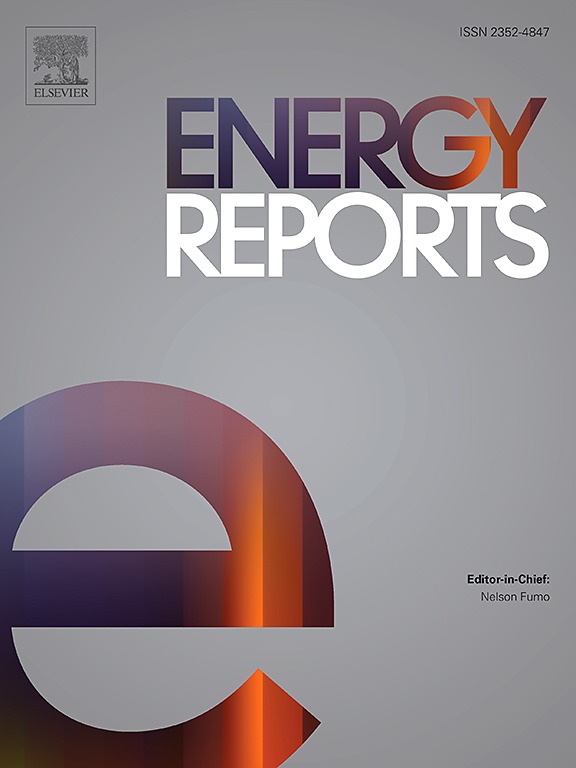基于全局信息增强自适应秃鹰搜索的光伏系统优化算法
IF 4.7
3区 工程技术
Q2 ENERGY & FUELS
引用次数: 0
摘要
太阳能光伏系统(SPVS)模型的参数估计是一个艰巨的优化挑战。解决这一问题的关键在于智能算法的有效性。通过解决三种光伏模型的参数优化问题,针对白头鹰搜索优化算法(BES)局部搜索能力有限、多样性不足、解性能欠佳等不足,提出了一种新的方法:虚拟粒子自适应白头鹰搜索优化算法(VABES)。整合到VABES中的是一个虚拟粒子更新机制,利用全面的种群信息来提高个体向最理想解决方案收敛的前景,同时防止种群陷入极端点。为了在群内的聚集和分散之间取得平衡,并增强VABES的全局优化能力,设计了一种自适应概率引导的Levy飞行校正方案。此外,还制定了一种基于动态突变因子的突变和交叉策略,以改进VABES的开发能力。对来自CEC2017和CEC2020的40个基准函数进行了100维测试,再加上非参数测试,结果表明VABES优于其他竞争性改进算法至少66% %。涉及57个实际问题的实验表明,VABES的总性能指标为0.1466,排名第一,与与bes相关的改进算法相比,VABES在处理约束优化方面具有显着优势。此外,三个光伏参数优化模型的求解过程表明,VABES收敛速度快,误差降低了26% %,在估计不同的光伏模型参数方面表现出一定的优势。本文章由计算机程序翻译,如有差异,请以英文原文为准。
Global information enhanced adaptive bald eagle search algorithm for photovoltaic system optimization
The parameter estimation of solar photovoltaic system (SPVS) models presents a formidable optimization challenge. The crux of resolving this issue lies in the efficacy of intelligent algorithms. By addressing the parameter optimization challenges associated with three photovoltaic models and targeting the deficiencies of the bald eagle search optimization algorithm (BES), such as its limited local search capability, inadequate diversity, and suboptimal solution performance, this article introduces a novel approach: the virtual-particle adaptive bald eagle search optimization algorithm (VABES). Incorporated into VABES is a virtual particle updating mechanism, leveraging comprehensive population information to enhance the prospects of individuals converging towards the most desired solution, while simultaneously preventing the population from becoming trapped at extreme points. To strike a balance between aggregation and dispersion within the swarm and bolster VABES's global optimization prowess, an adaptive probability-guided Levy flight correction scheme has been devised. Additionally, a dynamic mutation factor-based mutation and crossover strategy has been formulated to refine VABES's exploitation capabilities. The results of 100-dimensional tests conducted on 40 benchmark functions from CEC2017 and CEC2020, coupled with nonparametric testing, reveal that VABES outperforms at least 66 % of other competitive improved algorithms. Experiments involving 57 real-world problems demonstrate that VABES's total performance metric stands at 0.1466, ranking it first and showcasing its notable advantages in handling constrained optimization compared to BES-related improved algorithms. Furthermore, the solution processes for three photovoltaic parameter optimization models illustrate that VABES converges rapidly, reducing errors by 26 %, and exhibits certain advantages in estimating diverse photovoltaic model parameters.
求助全文
通过发布文献求助,成功后即可免费获取论文全文。
去求助
来源期刊

Energy Reports
Energy-General Energy
CiteScore
8.20
自引率
13.50%
发文量
2608
审稿时长
38 days
期刊介绍:
Energy Reports is a new online multidisciplinary open access journal which focuses on publishing new research in the area of Energy with a rapid review and publication time. Energy Reports will be open to direct submissions and also to submissions from other Elsevier Energy journals, whose Editors have determined that Energy Reports would be a better fit.
 求助内容:
求助内容: 应助结果提醒方式:
应助结果提醒方式:


